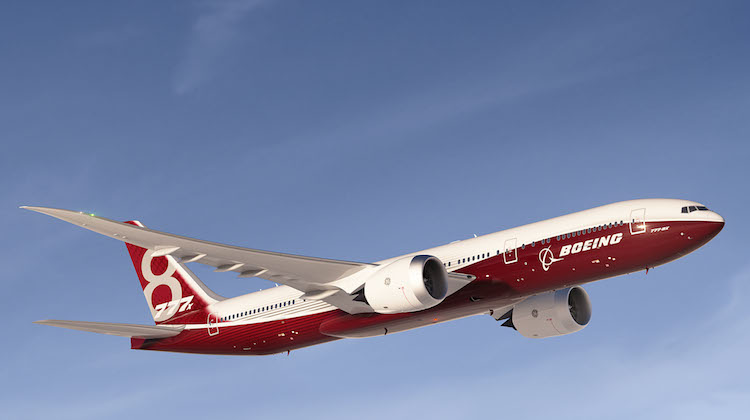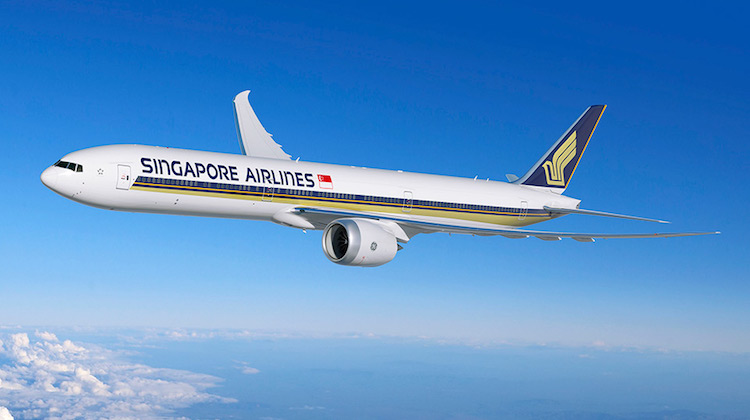
Boeing Commercial Airplanes vice president of marketing Randy Tinseth says he expects orders for the airframer’s in-development 777-8X large widebody to start coming in once the first 777-300ERs near retirement age.
Launched in 2013, the 777-X family comprises two variants, the 777-8X and 777-9X. The pair is an upgrade from Boeing’s in-production 777-200LR and and 777-300ER.
As at the end of October, the program had secured orders for 326 aircraft, the Boeing website shows, with 53 of those for the 777-8X and the remainder for the larger 777-9X.
Airlines that have ordered the aircraft include Lufthansa (20 777-9X), Emirates (35 777-8X and 115 777-9X), Cathay Pacific (21 777-9X) and Singapore Airlines (20 777-9X).


Of the seven airline customers, which does not count unidentified customers, three have opted for the 777-8X.
The 777-9X is 77 metres in length, has a total wingspan of 72 metres and is capable of flying 7,600nm when carrying 400-425 passengers in a two-class configuration, according to Boeing figures. The aircraft is scheduled to begin flight tests in 2019, with entry into service was expected to take place in 2020.

While the 777-8X is still in development and yet to reach firm configuration, the Boeing website lists the aircraft as having a range of 8,700nm and a passenger capacity of 350-375 passengers. The aircraft is expected to enter service in 2022.
Other new features include composite wings with folding wingtips to maintain the aircraft’s Code E rating at airports, as well as cabin enhancements such as larger overhead stowage and a wider cross-section.
Tinseth describes the 777-9X as “definitely the best big airplane in the market in the future”, given its capacity, range and operating economics.
“It’s the airplane that will replace the 747-400, ultimately the 747-8, and it is going to replace the A380,” Tinseth told reporters on the sidelines of the Association of Asia Pacific Airlines assembly of presidents in Jeju, South Korea on October 19.
And while the 777-8X has lagged the larger 777-9X in terms of orders, Tinseth noted the aircraft was the same size as the 777-300ER but had more modern engines and lower operating costs.
“The 777-8 is really about the replacement for the 777-300ER,” Tinseth said. “And we’re not going to see that replacement cycle for that aircraft until we get into the next decade.”
“So even though the 8 has lagged the 9, at the end of the day I think we have great opportunities, especially as the 777-300ERs start hitting 20 to 25 years in terms of their age.”
Figures from the Boeing website showed the manufacturer has delivered 796 777-300ERs since Air France was the first to fly the aircraft in 2004. There are 38 orders still outstanding for the popular big widebody.
According to aviation thinktank CAPA – Centre for Aviation, there are still some 792 777-300ERs in service today.

777-8X a contender for Qantas’s Project Sunrise challenge
One potential customer for the 777-8X is Qantas, which has laid down the challenge to Airbus and Boeing to deliver an aircraft capable of operating nonstop from Australia’s east coast to London and New York with a commercially viable payload by 2023 as part of its Project Sunrise challenge.
Air New Zealand too could be swayed to order the aircraft as its consideration of a replacement for its 777-200ER fleet takes in a desire to operate from Auckland to the United States east coast.
While Tinseth was tight-lipped on how well-placed Boeing was in meeting both carriers’ ambitions, the veteran aviation executive said there was great potential in these ultra-long-range routes.
“There’s no question that there is a market out there for some of those ultra long range airplanes,” Tinseth said.
“Australia, New Zealand is probable, since you are kind of on the edge of the world, there’s some opportunities there.
“But you also have got to take a look at both Qantas and Air New Zealand have done some pretty amazing things with their 787s or 777-300ERs or even A380s.”
“They’ve taken I think the best of what we’ve been able to offer in terms of the range of the airplanes and then coupled that with new ways in terms of how to navigate, and to optimise routing, and I think they have been able to benefit from that.”

Airbus’s contender for these ultra-long range routes is its A350 platform, with he A350-900ULR already in service with Singapore Airlines (SIA) on nonstop flights from Singapore to Los Angeles and New York (Newark).
Qantas chief executive Alan Joyce told the South China Morning Post both Airbus and Boeing were making good progress on producing an aircraft that met the airline’s requirements for payload and range as part of Project Sunrise.
“Our belief is [ultra-long-haul flights are] not going to be full passenger payload and freight, but there is sufficient capability to make it commercially viable,” Joyce told the newspaper on November 13.
Oceania not likely to see big orders any time soon
The Boeing 2018-2037 current market outlook foreshadows a need for 16,930 new aircraft in the 100-seat or greater segment in Asia over the next two decades.
The figure comprises 12,570 single-aisle, 3,810 widebody and 310 freighters alongside 240 regional jets.
Some 64 per cent of new deliveries would be for growth, with the total size of the fleet in Asia expected to grow from 7,360 in 2017 to 18,200 by 2037.
Based on those estimates, just 1,270 aircraft flying today will still be in service in 20 years time.
“This will be the largest single-aisle market in the world over the next 20 years, the largest widebody market as well as the largest freight market,” Tinseth said of the Asian market.
“The biggest growth markets in Asia are firstly China, South West Asia as well as South East Asia.
“The biggest replacement markets are in places like Australia, New Zealand, Japan, Taiwan, as well as here in Korea.”
Specifically on Australia and New Zealand, Tinseth said the airlines in the region had largely made their decisions on the narrowbody fleet in recent times, with one notable exception – Qantas’s evaluation of the eventual renewal of its 75-strong 737-800 fleet.
“If you think about it, Jetstar has made its single-aisle order, Virgin has made its. We look across the way at Air New Zealand, they have made theirs,” Tinseth explained.
“I think the only one that has yet to make that next generation decision is Qantas on single-aisles but it seems like they are focused on widebodies right now.
“I can always tell you that we are always looking to keep our customers and to replace those aircraft when they need to be replaced.”

In August, Boeing secured its first 737 MAX 10 customer in Oceania when Virgin Australia confirmed it would take delivery of 10 of the type from the end of 2020. The airline is expected to receive its first 737 MAX 8 in the final quarter of calendar 2019.
Tinseth said the 737 MAX 10 represented a growth vehicle for airlines, adding that the 600 or so orders since it launched the aircraft the MAX 10 in 2017 had exceeded expectations.
“We’ve strengthened our family,” Tinseth said. “And whether it be a 787 or a 777 or a 737, family is really important.”
“It gives our customers flexibility in the revenue that they can generate, but more importantly it gives them cost advantages.”
“It adds to the bottom line both ways, more revenue, optimise your revenue, lower costs, family is really important.”
“The MAX 10 has more range than any of the NGs today so you can plug it in your system seamlessly but it is really about upgauging and those core high-density routes making sense.”
VIDEO: A October 4 2018 video from the Boeing Livestream page that looks at the 777-X’s folding wingtips.










